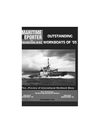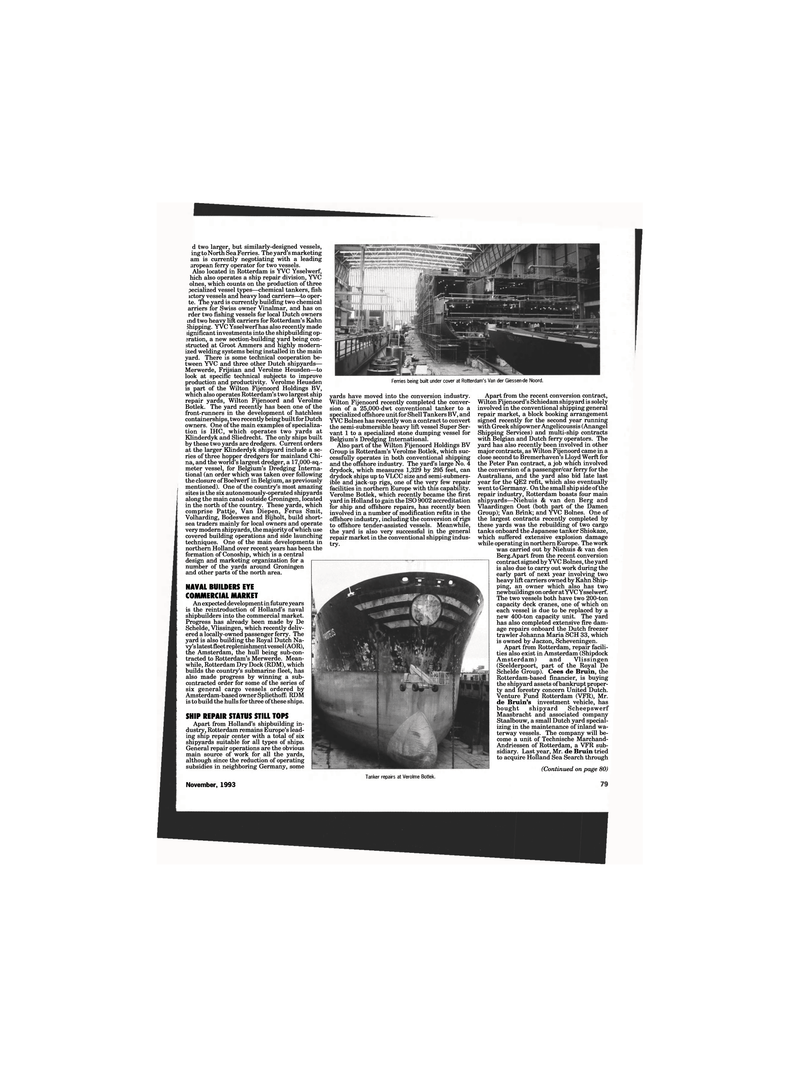
Page 77: of Maritime Reporter Magazine (November 1993)
Read this page in Pdf, Flash or Html5 edition of November 1993 Maritime Reporter Magazine
Ferries being built under cover at Rotterdam's Van der Giessen-de Noord. yards have moved into the conversion industry.
Wilton Fijenoord recently completed the conver- sion of a 25,000-dwt conventional tanker to a specialized offshore unit for Shell Tankers BV, and
YVC Bolnes has recently won a contract to convert the semi-submersible heavy lift vessel Super Ser- vant 1 to a specialized stone dumping vessel for
Belgium's Dredging International.
Also part of the Wilton Fijenoord Holdings BV
Group is Rotterdam's Verolme Botlek, which suc- cessfully operates in both conventional shipping and the offshore industry. The yard's large No. 4 drydock, which measures 1,329 by 295 feet, can drydock ships up to VLCC size and semi-submers- ible and jack-up rigs, one of the very few repair facilities in northern Europe with this capability.
Verolme Botlek, which recently became the first yard in Holland to gain the ISO 9002 accreditation for ship and offshore repairs, has recently been involved in a number of modification refits in the offshore industry, including the conversion of rigs to offshore tender-assisted vessels. Meanwhile, the yard is also very successful in the general repair market in the conventional shipping indus- try.
Tanker repairs at Verolme Botlek.
Apart from the recent conversion contract,
Wilton Fijenoord's Schiedam shipyard is solely involved in the conventional shipping general repair market, a block booking arrangement signed recently for the second year running with Greek shipowner Angelicoussis (Anangel
Shipping Services) and multi-ship contracts with Belgian and Dutch ferry operators. The yard has also recently been involved in other major contracts, as Wilton Fijenoord came in a close second to Bremerhaven's Lloyd Werft for the Peter Pan contract, a job which involved the conversion of a passenger/car ferry for the
Australians, and the yard also bid late last year for the QE2 refit, which also eventually went to Germany. On the small ship side of the repair industry, Rotterdam boasts four main shipyards—Niehuis & van den Berg and
Vlaardingen Oost (both part of the Damen
Group); Van Brink; and YVC Bolnes. One of the largest contracts recently completed by these yards was the rebuilding of two cargo tanks onboard the Japanese tanker Shiokaze, which suffered extensive explosion damage while operating in northern Europe. The work was carried out by Niehuis & van den
Berg.Apart from the recent conversion contract signed by YVC Bolnes, the yard is also due to carry out work during the early part of next year involving two heavy lift carriers owned by Kahn Ship- ping, an owner which also has two newbuildings on order at YVC Ysselwerf.
The two vessels both have two 200-ton capacity deck cranes, one of which on each vessel is due to be replaced by a new 400-ton capacity unit. The yard has also completed extensive fire dam- age repairs onboard the Dutch freezer trawler Johanna Maria SCH 33, which is owned by Jaczon, Scheveningen.
Apart from Rotterdam, repair facili- ties also exist in Amsterdam (Shipdock
Amsterdam) and Vlissingen (Scelderpoort, part of the Royal De
Schelde Group). Cees de Bruin, the
Rotterdam-based financier, is buying the shipyard assets of bankrupt proper- ty and forestry concern United Dutch.
Venture Fund Rotterdam (VFR), Mr. de Bruin's investment vehicle, has bought shipyard Scheepswerf
Maasbracht and associated company
Staalbouw, a small Dutch yard special- izing in the maintenance of inland wa- terway vessels. The company will be- come a unit of Technische Marchand-
Andriessen of Rotterdam, a VFR sub- sidiary. Last year, Mr. de Bruin tried to acquire Holland Sea Search through (Continued on page 80) d two larger, but similarly-designed vessels, ing to North Sea Ferries. The yard's marketing am is currently negotiating with a leading aropean ferry operator for two vessels.
Also located in Rotterdam is YVC Ysselwerf, hich also operates a ship repair division, YVC olnes, which counts on the production of three pecialized vessel types—chemical tankers, fish ictory vessels and heavy load carriers—to oper- te. The yard is currently building two chemical arriers for Swiss owner Vinalmar, and has on rder two fishing vessels for local Dutch owners ind two heavy lift carriers for Rotterdam's Kahn
Shipping. YVC Ysselwerf has also recently made significant investments into the shipbuilding op- eration, a new section-building yard being con- structed at Groot Ammers and highly modern- ized welding systems being installed in the main yard. There is some technical cooperation be- tween YVC and three other Dutch shipyards—
Merwerde, Frijsian and Verolme Heusden—to look at specific technical subjects to improve production and productivity. Verolme Heusden is part of the Wilton Fijenoord Holdings BV, which also operates Rotterdam's two largest ship repair yards, Wilton Fijenoord and Verolme
Botlek. The yard recently has been one of the front-runners in the development of hatchless containerships, two recently being built for Dutch owners. One of the main examples of specializa- tion is IHC, which operates two yards at
Klinderdyk and Sliedrecht. The only ships built by these two yards are dredgers. Current orders at the larger Klinderdyk shipyard include a se- ries of three hopper dredgers for mainland Chi- na, and the world's largest dredger, a 17,000-sq.- meter vessel, for Belgium's Dredging Interna- tional (an order which was taken over following the closure of Boelwerf in Belgium, as previously mentioned). One of the country's most amazing sites is the six autonomously-operated shipyards along the main canal outside Groningen, located in the north of the country. These yards, which comprise Pattje, Van Diepen, Ferus Smit,
Volharding, Bodeswes and Bijholt, build short- sea traders mainly for local owners and operate very modern shipyards, the majority of which use covered building operations and side launching techniques. One of the main developments in northern Holland over recent years has been the formation of Conoship, which is a central design and marketing organization for a number of the yards around Groningen and other parts of the north area.
NAVAL BUILDERS EYE
COMMERCIAL MARKET
An expected development in future years is the reintroduction of Holland's naval shipbuilders into the commercial market.
Progress has already been made by De
Schelde, Vlissingen, which recently deliv- ered a locally-owned passenger ferry. The yard is also building the Royal Dutch Na- vy's latest fleet replenishment vessel (AOR), the Amsterdam, the hull being sub-con- tracted to Rotterdam's Merwerde. Mean- while, Rotterdam Dry Dock (RDM), which builds the country's submarine fleet, has also made progress by winning a sub- contracted order for some of the series of six general cargo vessels ordered by
Amsterdam-based owner Spliethoff. RDM is to build the hulls for three of these ships.
SHIP REPAIR STATUS STILL TOPS
Apart from Holland's shipbuilding in- dustry, Rotterdam remains Europe's lead- ing ship repair center with a total of six shipyards suitable for all types of ships.
General repair operations are the obvious main source of work for all the yards, although since the reduction of operating subsidies in neighboring Germany, some
November, 1993 79

 76
76

 78
78
